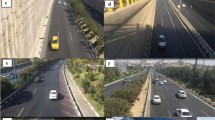Abstract
Mobility on roads is influenced by many factors like pavement surface condition, shoulder, driver skills, width of carriageway, roadside activities and type of terrain. Lateral clearance is the distance maintained by moving vehicle from the friction. Frictional activities along the road significantly influence speed and lateral clearance. In this study the influence of friction types on travel speed and lateral clearance for State highways (SH) and Major district roads (MDR) has been explored. The reduction in speed was found to be lowest for all the types of friction for two-wheelers and high for buses and trucks. The reduction in speed is found to be lesser on MDR compared to SH for cars, buses and trucks with respect to friction types of parking and roadside marketing. The lateral clearances maintained by trucks and buses are lesser compared to two-wheelers, three-wheelers, tractors and cars on SH. Reductions in lateral clearance distances on MDR are observed for different types of vehicles with respect to types of friction compared to SH.
Access this chapter
Tax calculation will be finalised at checkout
Purchases are for personal use only
Similar content being viewed by others
References
Das AK, Bhuyan PK (2017) Hardcl method for defining LOS criteria of urban streets. Int J Civ Eng 15(7):1077–1086
Bang KL, Carlsson A, Palgunadi (1995) Development of speed flow relationship for indonesian rural roads using empirical data and simulation. Transp Res Rec, Washington DC, pp 24–32
Chiguma MLM (2007) Analysis of side friction impacts on urban road links. KTH School of Architecture and the Built Environment, Stockholm, Sweden
Munawar A (2011) Speed and capacity for urban roads, Indonesian experience. Procedia Soc Behav Sci 382–387
Koshy RZ, Arasan VT (2005) Influence of bus stops on flow characteristics of mixed traffic. J Transp Eng 131(8):640–643
Chandra S, Rao GS, Dhamaniya A (2014) Effect of pedestrian cross-flow on capacity of urban arterials. Indian Highways 42(1):51–58
Salini S, George S, Ashalatha R (2016) Effect of side frictions on traffic characteristics of urban arterials. Transp Res Procedia 17:636–643. https://doi.org/10.1016/j.trpro.2016.11.118
Ashalatha R, Shalini S, Prakash N (2013) Capacity reduction of urban roads due to bus stops. Transp Res Board
Patel CR, Joshi GJ (2014) Mixed traffic speed–flow behavior under influence of road side friction and non-motorized vehicles: a comparative study of arterial roads in India. Int J Civ Environ Struct Construct Architect Eng 8(11):1198–1204
Pal S, Roy SK (2019) Impact of side friction on performance of rural highways in India. J Infrastruct Syst 25(2):04019006. https://doi.org/10.1061/(asce)is.1943-555x.0000476
Bhuyan PK, Krishna Rao KV (2011) Defining level of service criteria of urban streets in Indian context. Euro Transp 38–52
Van der Horst R, de Ridder S (2007) Influence of roadside infrastructure on driving behavior. Transp Res Rec: J Transp Res Board 2018(1):36–44. https://doi.org/10.3141/2018-06
Antonson H, Mardh S, Wiklund M, Blomqvist G (2009) Effect of surrounding landscape on driving behavior: a driving simulator study. J Environ Psychol 29(4):403–502. https://doi.org/10.1016/j.jenvp.2009.03.005
Peng Y, Geedipally S, Lord D (2012) Effect of roadside features on single-vehicle roadway departure crashes on rural two-lane roads. Transp Res Rec: J Transp Res Board 2309(1):21–29. https://doi.org/10.3141/2309-03
Bella F (2013) Driver perception of road side configurations on two-lane rural roads: effects on speed and Lateral placement. Accid Anal Prev 50:251–262. https://doi.org/10.1016/j.aap.2012.04.015
Jamson S, Lai F, Jamson H (2010) Driving simulators for robust comparisons: a case study evaluating road safety engineering treatments. Accid Anal Prev 42(3):961–971. https://doi.org/10.1016/j.aap.2009.04.014
Ben-Bassat T, Shinar D (2011) Effect of shoulder width, guardrail and roadway geometry on driver perception and behavior. Accid Anal Prev 43:2142–2152
Dhamaniya A, Chandra S (2017) Influence of operating speed on capacity of urban arterial midblock sections. Int J Civ Eng 15(7):1053–1062. https://doi.org/10.1007/s40999-017-0206-7
Yang Q, Overton R, Han L, Yan X, Richards S (2013) The influence of curbs on driver behaviors in four-lane rural highways: a driving simulator based study. Accid Anal Prev 50:1289–1297. https://doi.org/10.1016/j.aap.2012.09.031
Salini S, Ashalatha R (2018) Analysis of traffic characteristics of urban roads under the influence of roadside frictions. Case Stud Transp Policy. https://doi.org/10.1016/j.cstp.2018.06.008
Parkar M, Dhamaniya A (2020) Developing capacity reduction factors for curbside bus stops under heterogeneous traffic conditions. Arab J Sci Eng 45:3921–3935
Golakiya HD, Patkar M, Dhamaniya A (2019) Impact of midblock pedestrian crossing on speed characteristics and capacity of urban arterials. Arab J Sci Eng 44:8675–8689
Parkar M, Dhamaniya A (2019) Effect of on-street parking on effective carriageway width and capacity of urban arterial roads in India. Euro Transp\Trasporti Europei 73, ISSN 1825–3997
Parkar M, Dhamaniya A (2020) Influence of Nonmotorized Vehicles on Speed Characteristics and Capacity of Mixed Motorized Traffic of Urban Arterial Midblock Sections. J Transp Eng Part—A 146(4):04020013
Author information
Authors and Affiliations
Corresponding author
Editor information
Editors and Affiliations
Rights and permissions
Copyright information
© 2023 The Author(s), under exclusive license to Springer Nature Singapore Pte Ltd.
About this paper
Cite this paper
Santosh, S.K., Geethanjali, S., Archana, M.R., Anjaneyappa, V. (2023). Influence of Roadside Friction on Speed and Lateral Clearance for Different Types of Vehicles. In: Anjaneyulu, M.V.L.R., Harikrishna, M., Arkatkar, S.S., Veeraragavan, A. (eds) Recent Advances in Transportation Systems Engineering and Management. Lecture Notes in Civil Engineering, vol 261. Springer, Singapore. https://doi.org/10.1007/978-981-19-2273-2_41
Download citation
DOI: https://doi.org/10.1007/978-981-19-2273-2_41
Published:
Publisher Name: Springer, Singapore
Print ISBN: 978-981-19-2272-5
Online ISBN: 978-981-19-2273-2
eBook Packages: EngineeringEngineering (R0)




